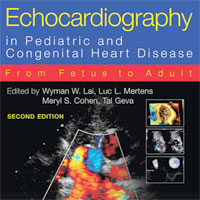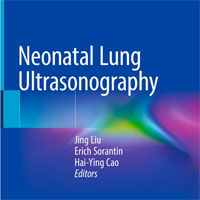Tag: pediatrics
New Technology Gives Parents Virtual Face Time With Their Hospitalized Children
The pediatric intensive care unit (PICU) team at the University of Maryland Children's Hospital (UMCH) is offering a new way for families to interact with their child and the medical team when they can’t be there in person. PICU... read more
Life Following Pediatric Septic Shock
Margaret M. Parker, MD, MCCM, and Jerry J. Zimmerman, MD, PhD, FCCM, talk about the trajectory of long-term mortality and significant health-related quality of life disability among children encountering septic shock. This... read more
Echocardiography in Pediatric and Congenital Heart Disease
This comprehensive textbook on the echocardiographic assessment of pediatric and congenital heart disease has been updated for a second edition with an emphasis on new technologies. This highly-illustrated full-color reference... read more

Guidelines for the Management of Septic Shock and Sepsis-Associated Organ Dysfunction in Children
A large cohort of international experts was able to achieve consensus regarding many recommendations for the best care of children with sepsis, acknowledging that most aspects of care had relatively low quality of evidence... read more
Blood Transfusion – Fresh vs. Standard-issue in Critically Ill Pediatric Patients
Among critically ill pediatric patients, the use of fresh red blood cells did not reduce the incidence of new or progressive multiple organ dysfunction syndrome (including mortality) compared with standard-issue red blood... read more
Neonatal Lung Ultrasonography
This book presents lung ultrasound as an accurate, reliable, low-cost and simple imaging technique, which poses no risk of radiation damage, making bedside use both feasible and convenient in neonatal wards. The aim of... read more

Depth of Anesthesia in Children Undergoing Cardiac Surgery Under Extracorporeal Circulation
In children undergoing cardiac surgery in our department, the use of sevoflurane-balanced anesthesia during cardiopulmonary bypass showed no superiority of inhalational agents over total intravenous anesthesia with opioids... read more
Holding Intubated Infants Well Tolerated and Safe
Critically ill infants who are old enough to move on their own but too young to cooperate with care instructions have been among the last to benefit from patient mobility initiatives. Results from a holding intervention... read more
Serum Protein Changes in Pediatric Sepsis Patients Identified with an Aptamer-Based Multiplexed Proteomic Approach
The serum protein changes identified with the aptamer-based multiplexed proteomics approach used in this study can be useful to distinguish between sepsis and noninfectious systemic inflammation. A cohort of 40 children... read more
Optimal Duration of Mechanical Ventilation and Influencing Factors Following Mandibular Distraction Osteogenesis in Infants
Mandibular distraction osteogenesis (MDO) is an effective treatment for tongue-based airway obstruction in infants with severe Pierre Robin sequence (PRS). Most infants receiving MDO require postoperative mechanical ventilation... read more
Fully Automated, Real-time, Calibration-free, Continuous Noninvasive Estimation of Intracranial Pressure in Children
This nICP estimation algorithm, based on arterial blood pressure (ABP) and bedside transcranial Doppler (TCD) cerebral blood flow velocity (CBFV) waveform measurements, performs in a manner comparable to invasive intracranial... read more
Association of Severe Hyperoxemia Events and Mortality Among Patients Admitted to a PICU
Greater numbers of severe hyperoxemia events appeared to be associated with increased mortality in this large, diverse cohort of critically ill children, supporting a possible exposure-response association between severe... read more
Defining Benefit Threshold for ECMO in Children with Sepsis
This binational study demonstrates that a rapidly available sepsis mortality prediction model can define thresholds for survival benefit in children with septic shock considered for ECMO. Survival on ECMO was associated... read more
Seizure Detection Algorithms in Critically Ill Children
Some commercially available seizure detection algorithms demonstrate performance for seizure detection that is comparable to that of electroencephalography experts using quantitative electroencephalography displays. Continuous... read more
Apneic Oxygenation As a Quality Improvement Intervention in an Academic PICU
Implementation of apneic oxygenation in PICU was feasible, and was associated with significant reduction in moderate and severe oxygen desaturation. Use of apneic oxygenation should be considered when intubating critically... read more
Clinical Profile and Predictors of Outcome of Pediatric ARDS in a PICU
Pediatric acute respiratory distress syndrome (ARDS) contributes to a significant burden in the PICU of a developing country and is associated with significantly higher mortality. Infection remains the most common etiology.... read more
Epidemiology of Pediatric Severe Sepsis in Main PICU Centers in Southwest China
This multicenter study demonstrates that pediatric severe sepsis is common and is a factor in the high mortality rate that is observed in PICUs in Southwest China. The mortality rate remains high; therefore, improved... read more
Fentanyl Infusion Pharmacokinetics Variables in Obese and Nonobese Children
The differences in total clearance (CLS) may increase less than proportional to weight in obese children greater than 6-year-olds, while volume of distribution at steady state increases more than proportional to weight in... read more
Fresh Red Blood Cell Transfusions No More Beneficial Than Older Red Blood Cells
Researchers have found that transfusions using fresh red blood cells—cells that have spent seven days or less in storage—are no more beneficial than older red blood cells in reducing the risk of organ failure or death... read more
Ventilation Rates and Pediatric In-Hospital Cardiac Arrest Survival Outcomes
In this multicenter cohort, ventilation rates exceeding guidelines were common. Among the range of rates delivered, higher rates were associated with improved survival to hospital discharge. Arterial blood pressure and... read more
Timing of Tracheostomy in Pediatric Patients
In children on mechanical ventilation, early tracheostomy may improve important medical outcomes. However, our data demonstrate the urgent need for high-quality, randomized controlled trials in the pediatric population. Data... read more
PICU Up! A Multicomponent Early Mobility Intervention for Critically Ill Children
Pediatric intensive units traditionally have had a culture where critically ill children are intubated and mechanically ventilated, immobilized, and highly sedated. This practice is primarily driven by a focus on safety... read more









